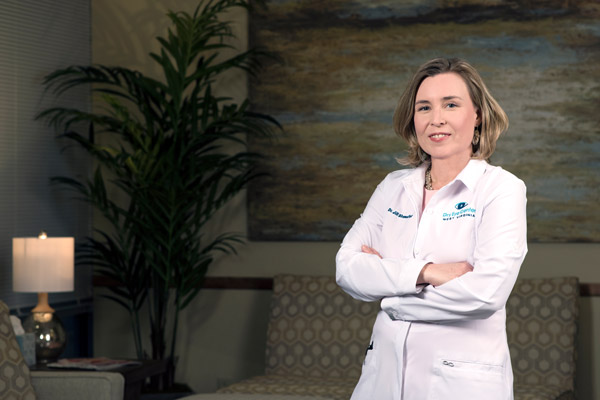

In 2005, Jill Showalter, OD, and her father, Douglas Ritchie, OD, opened EyeDoctors in Vienna, West Virginia. Five years later, she took control as sole owner of the business, continuing the practice’s mission of providing excellent vision care services while remaining on the cutting edge of technology. The practice’s continual growth prompted the development of a separate facility for the diagnosis and treatment of dry eye disease.
The Dry Eye Center of West Virginia opened in 2017, a few doors down from the main office. It provided the perfect opportunity to expand the practice without having to undergo the cost or inconvenience of a move. “When that space became available, I realized it could be used for the Dry Eye Center, and it also allowed us to move optical billing and insurance verification there, opening up some space in the current location,” Dr. Showalter says.
Both offices provide patients with a variety of advanced vision services and medical treatments, many of which are accompanied by a hefty price tag. Wanting to ensure that patients could access the services and products they needed, she began accepting CareCredit health care credit cards as a way to help qualified patients finance these purchases. “CareCredit has provided many of our patients with affordable access to the care they need. Many of the patients referred to the Dry Eye Center may not have the cash on hand for the critical products and services prescribed to treat their dry eye disease. Thanks to CareCredit financing, our patients tell us continuously about their improved quality of life,” she says.
CareCredit has been utilized successfully at EyeDoctors for several years, but Dr. Showalter was unsure how it would function in the dry eye space. That uncertainty dissipated quickly. “Many dry eye treatments aren’t covered by most insurance plans, so there’s some sticker shock for patients when they hear that it’s nearly $1,000. But I realized that if I explained the CareCredit financing options in the exam room, as we did in the optical dispensary, it became much more manageable for patients,” she says. The new center offers a diverse range of dry eye treatments, including LipiFlow, punctal plugs and Prokera amniotic membrane corneal bandages. In the year that the Dry Eye Center has been open, about half of the dry eye patients have used their CareCredit cards to pay for the
treatments.


The Dry Eye Center receives patient referrals from across the state due to its unique services and treatment options, but the majority are already patients of EyeDoctors. During routine examinations in the main facility, patients complete a modified Ocular Surface Disease Index scale questionnaire. This determines which patients are potential dry eye sufferers. Those who check yes to three or more symptoms are tested for dry eye with the TearLab Osmolarity System and corneal fluorescein staining, which determines the severity of dry eye. “We’ll start some baseline treatment, and then we refer the patient to the Dry Eye Center after six weeks to gauge the response,” Dr. Showalter says.
Once she began incorporating this questionnaire into vision exams, Dr. Showalter realized the prevalence of dry eye disease in the area. “I was surprised by the incidence and the presentation. I have had patients whose only symptom was a little bit of blurred vision, but the TearLab results showed a high level of dry eye. Others, whose clinical findings showed moderate dry eye, tell me how much better they see after they’ve begun treatment.”


As a dry eye sufferer herself, Dr. Showalter is resolute in identifying and helping as many patients as possible. For those enduring dry eye symptoms, it’s wonderful that her practice not only has the technology to diagnose and treat them but also the financial tools to help them access this level of care. The use of CareCredit has been essential to her quest to serve this influx of patients suffering from this disease.
CareCredit offers advice to practitioners looking to focus on this area of care. Click here to view the digital publication.



